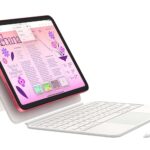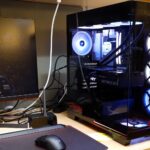I’ve been a proud and vociferous Android fan since the Nexus One…but there’s an iPad sitting on my desk, not an Android tablet. Apple has consistently and reliably beaten the pants off the competition when it comes to tablets, to the point that only Samsung competes at the high end. But when it comes to a smaller, high-quality tablet, not even Samsung wants to take on the mighty iPad Mini.
And that’s a shame. There’s a market for smaller, high-end tablets, something that’s more comfortable to hold and read for longer periods of time than a 10-inch or 12-inch screen. But the iPad Mini is so good, or perhaps just sells so well, that every competitor thinks it’s a waste of time to try and take a shot at it. And they’re probably right.
I should know, I’ve looked — the iPad Mini just got a seventh-gen refresh, after being unchanged for three years. In that time I didn’t find a single alternative for an 8- or 9-inch Android tablet in the same high-end category. There are a few different factors at play here, so let’s examine them.
Who’s afraid of the big bad little tablet?
One, if you’re wading into the waters of a smaller tablet, you’re also going to be competing with cheaper tablets. The iPad Mini starts at $500 retail (going up to a whopping $950 for all the bells and whistles!), but on paper, you can find something very similar on the Android side of things for around $150 or less if you deal hunt. And I’m not talking no-name brands here — Samsung and Lenovo both have offerings in this category, to say nothing of the Amazon Fire series, which is probably the most well-known after the iPad.
The Lenovo Tab M9, a typical budget offering, starts at just $140.
Lenovo
That is a crowded and contentious market, for margins that are very low. So trying to make a small Android tablet that’s either a good deal, or competitive with the iPad Mini in terms of quality, is putting yourself between a rock and a hard place.
It’s been tried before. As an Android reporter and reviewer I remember a slew of tablets like the second-gen Nexus 7, the LG G Pad (which also came in a nice Google-fied package), and Samsung’s smaller Tab and Note designs. Unsurprisingly, all of these lines have fizzled out. Customers either went bigger with something like a Galaxy S tablet (with its very nice OLED screens!), cheaper with an Amazon or similar design, or just went with the iPad.

High-end Android tablets were a thing ten years ago, like this LG G Pad 8.3 Google Play Edition (LGGP83GPE, for short).
LG
So that’s the price factor. But there’s another angle that makes selling a smaller, high-end Android tablet daunting: you’re fighting on form factor, too.
Over the last few years I’ve tried to find a high-end phone under 6 inches for my sister. It’s damn near impossible, especially in the American market. Phones have gotten absolutely massive, to the point that an 7- or 8-inch tablet just doesn’t make sense when even budget smartphones start in the 6.5-inch range and get bigger.
And that’s just in something that’s comparable in size. Personally, I’ve almost completely abandoned the tablet form factor since getting a Galaxy Z Fold 6. Sure, its unfolded screen isn’t quite as big as an iPad Mini…but I can carry it in my pocket without the need for an extra bag, and I don’t need to get a second data connection or tether to my phone.

Folding phones are nearly the same size and small tablets, and bigger standard smartphones are almost as large.
Michael Crider/Foundry
Smaller tablets are being bombarded from both the budget and high-end side of the smartphone market. It seems like only Apple can make a high-end model work — everyone else is stuck selling budget models for kids or other niche applications, like industrial POS management.
But despite my doom and gloom, you do have a couple of options beyond Apple if you want something better than an Amazon Fire at this size.
“Gaming tablets”
There are a very few small tablet models that strive to be better than a budget design, and they’re also aiming for a niche: gamers. Lenovo’s Legion Tab is an 8.8-inch Android-powered tablet meant to be comfortable held for long mobile gaming sessions. But even if you’re not a gamer, its high-quality 144hz screen, Snapdragon 8+ processor, and dual stereo speakers are a cut above the competition.
Unfortunately Lenovo seems to have run into the same problem as everyone else. Though the Legion Tab is on its second generation, it doesn’t seem to have been updated since 2023, and Lenovo isn’t even selling it on its online store. From what I can tell it never even came to the US market. You can find the Y700 model on places like AliExpress or other import shops for a little under $300, or much more from a third-party shop on Walmart.
Razer made one of these Snapdragon-powered gaming tablets too, though at 6.8 inches, the Edge is much closer to a phone than a tablet (you can even buy it right from Verizon with a 5G radio). It’s also on the pricey side at $400, though it does come with a very nice Kishi mobile controller. But again, if you’re getting a tablet that small, odds are pretty good that you can get a similar experience with your phone by just adding the controller on top.
I can’t help but think these gaming tablets are facing their own form factor crunch, between competition from standard phones and new portable gaming devices, both Android and PC-powered, to say nothing of Nintendo’s 800-pound Switch gorilla. (That’s 800 pounds in a figurative, market share sense — the real thing is a little lighter.)
Okay, your options in the “gaming” area are pretty slim, and barely better than a budget tablet. But what about…
E-readers
If you’re looking for a smaller tablet, odds are you want one that’s comfy in one hand, and that might mean you’re looking to read for long periods of time. While small, high-end tablets are apparently a dying niche, there’s been an explosion in the area of high-quality e-readers. Thanks to more available E-ink screens, tons of companies are stepping up to challenge Amazon’s Kindle, with color to boot…and they’re doing it with Android-powered tablets.
The Boox Tab Mini C is my pick here. At 7.8 inches with a more square-ish 1872 x 1404 screen, it’s pretty similar to the iPad Mini in terms of both size and in-the-hand experience. And despite using an e-paper display, it’s a tablet, not really a reader. The Kaleido color screen and relatively high refresh make it more than capable of handling web browsing and email in addition to books and comics. It’s also a lot easier on your eyes (literally) for long periods of use. Front lighting makes it functional, if not ideal, in the dark.
There are some compromises, though. While Boox uses Android software, it’s running on a practically ancient Android 11 build with a lot of customization. You get access to the Google Play Store, but expect a lot of quirks from third-party apps. The screen’s very low refresh means that video is all but unwatchable, and any games more action-packed than checkers are a no-go.
So yeah, it’s a much better reader than the iPad Mini, but not a better all-around tablet. And if that’s what you’re after in this $350 price range, you might be more comfortable with a Kindle Paperwhite, warts and all. (The warts in this case are a black-and-white screen and no access to third-party apps.) The Kobo Libra Colour is a good middle ground between the two, offering less restrictive access to more books and comics, but not wide-open Android app access.
Even Apple can’t do this forever
I should point out that even as the de facto standard for a small, high-end tablet, Apple has made some compromises. I mentioned that the iPad Mini went three years without an update, but even the new model isn’t what fans really wanted. It’s running on the same A17 Pro chip as the iPhone 15…but not the M-series chip that the iPad Air and iPad Pro upgraded to years ago. Macworld called it a “minor update” for an already-dated design.
So even Apple thinks this $500 tablet can get by just fine on mobile hardware, and doesn’t get access to some of the more impressive multi-tasking capabilities that the big boys do. That makes the iPad Mini uncomfortably close to the standard iPad ($350) in capability, to say nothing of price and looks. Even in Apple’s own lineup, the iPad Mini is being squeezed from above and below.
At this point I’m tempted to make a plea to Samsung to give the small, high-end tablet category another swing. I have fond memories of the Galaxy Tab S 8.4 from 2014, one of the few small tablets with an OLED screen, a focus on multi-tasking, and great accessory support. I’d mention Google too, if wishes were horses.
But having laid out the realities of the tablet market at the moment, the truth is that I fully understand why no one is willing to compete here. If even Apple doesn’t believe in small tablets enough to offer up its best hardware, then there’s no point in chasing this particular waterfall. What a shame.
Read the full article here












